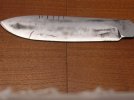- Joined
- Jun 21, 1999
- Messages
- 752
This is some O-1/1095 damascus we made at the blade school last summer. I foged it last week and heat treated it today. I file tested and heated and quenched again cause it wasn't very hard. When I started cleaning it up I noticed the cracks. I've outlined them with a sharpie.
I forged it bright orange hot and was careful not to hit it cold. Normalized x3. Ground it. Normalized x3. Then heated to non magnetic and quenched in heated olive oil (very quickly..1-2 seconds from forge to oil). I let it stay in the oil for about 5-10 min then wiped it off and washed it in warm water....
Any ideas on what went wrong and how to avoid doing this in the future?
Also, I am contemplating trying to salvage a smaller blade out of this mess. Is that advisable? I'd re anneal and then grind it down. Any input would be appreciated.
Thanks,
Ed

